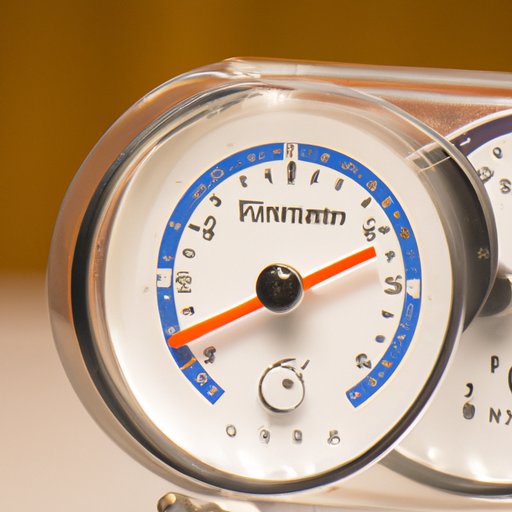Introduction
A hygrometer is an instrument used to measure the relative humidity in a given environment. It can be used to determine the amount of moisture in the air as well as the temperature. Hygrometers are commonly used to monitor the humidity levels in homes, offices, greenhouses, and other enclosed spaces. This article will provide an in-depth look at how a hygrometer works, from the basics of its function to exploring the principles behind its readings and the benefits of using a hygrometer.
An Overview of How a Hygrometer Works
At its most basic level, a hygrometer works by measuring the amount of water vapor in the air. The measurement is then converted into a percentage, which is known as the relative humidity. This is the ratio of the amount of water vapor in the air compared to the maximum amount of vapor that the air could hold at a given temperature. Different types of hygrometers work in different ways, but they all use some form of sensor or probe to measure the amount of moisture in the air.
There are several types of hygrometers available on the market, including electronic and mechanical models. Electronic hygrometers use sensors to measure the amount of water vapor in the air and then convert the readings into a percentage. Mechanical hygrometers, on the other hand, rely on the principle of evaporation to measure humidity. These hygrometers typically consist of two metal plates connected to a spring. As the humidity increases, the plates absorb more moisture, causing the spring to expand, which in turn moves a needle on a gauge to indicate the relative humidity.

The Principles Behind Hygrometer Readings
In order to understand how a hygrometer works, it is important to understand the science behind its readings. Hygrometers measure the amount of water vapor in the air, which is known as the absolute humidity. This is expressed as grams of water per cubic meter of air. The relative humidity, on the other hand, is the ratio of the amount of water vapor in the air compared to the maximum amount of vapor that the air could hold at a given temperature.
The components of a typical hygrometer include a sensor, a controller, and a display. The sensor is responsible for measuring the amount of water vapor in the air, while the controller converts the readings into a percentage. Finally, the display shows the relative humidity reading in a numerical format. By understanding these components and the principles behind hygrometer readings, it is possible to gain a better understanding of how a hygrometer works.

The Benefits of Using a Hygrometer
Using a hygrometer provides many benefits, from helping to maintain comfortable humidity levels indoors to monitoring the growth of plants in greenhouses and other controlled environments. By measuring the relative humidity, a hygrometer can help ensure that the air in an indoor space is neither too dry nor too humid. Too much humidity can lead to condensation, mold, and mildew, while too little humidity can cause static electricity and a feeling of dryness in the air.
Hygrometers are also commonly used in greenhouses and other controlled environments to monitor the growth of plants. By measuring the relative humidity, it is possible to adjust the humidity levels to ensure optimal plant growth. Additionally, hygrometers can be used to measure the dew point, which is the temperature at which the air is saturated with water vapor and condensation begins to form.
Conclusion
This article provided an in-depth look at how a hygrometer works, from the basics of its function to exploring the principles behind its readings and the benefits of using a hygrometer. By understanding the science behind hygrometer readings and the components of a typical hygrometer, it is possible to gain a better understanding of how this device works. Additionally, using a hygrometer provides many benefits, such as helping to maintain comfortable humidity levels indoors and monitoring the growth of plants in greenhouses and other controlled environments.
Overall, understanding how a hygrometer works is essential for anyone who wants to make sure their environment is properly regulated. By having a good grasp of the science behind hygrometer readings, it is possible to make sure that the air in an indoor space is neither too dry nor too humid, and that plants are receiving the right amount of humidity for optimal growth.
(Note: Is this article not meeting your expectations? Do you have knowledge or insights to share? Unlock new opportunities and expand your reach by joining our authors team. Click Registration to join us and share your expertise with our readers.)
